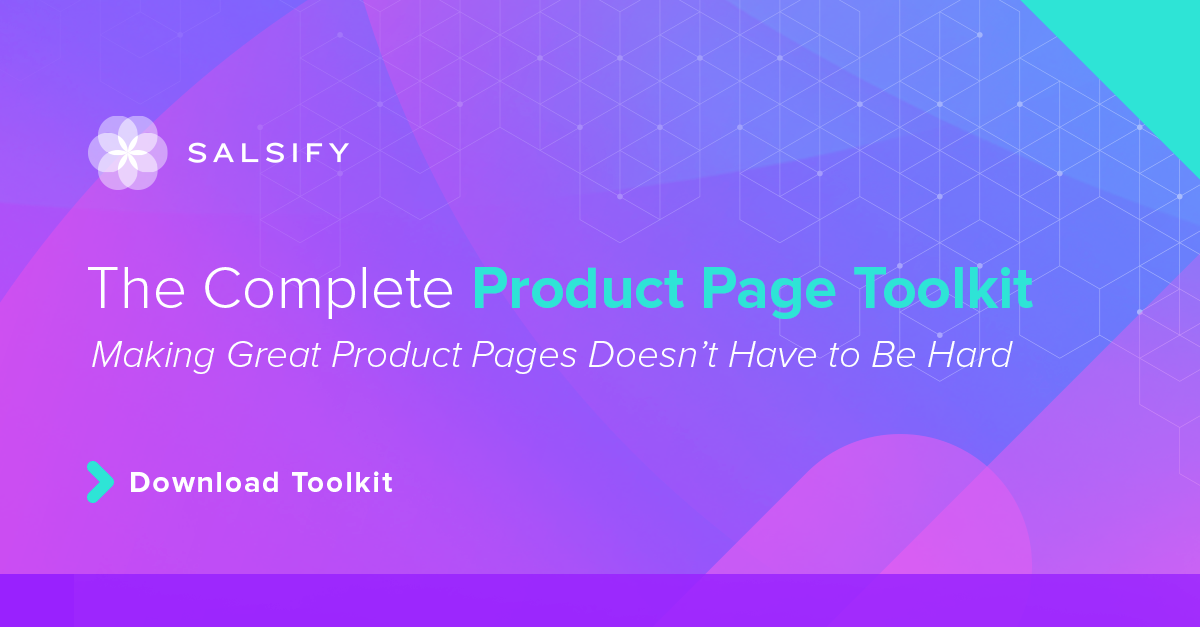

The Complete Product Page Toolkit
Download this product page toolkit to get everything you need to create engaging, high-performing product pages that drive sales and build trust with shoppers.
DOWNLOAD TOOLKITPIM
Manage all product content in one central system of record.
Syndication
Easily syndicate product content to every consumer touch point.
Enhanced Content
Enrich product pages with below-the-fold content and rich media.
Intelligence Suite
Bring AI-powered capabilities directly into your Salsify workflows.
Grocery Accelerator
Leverage the first-ever category-wide PXM accelerator in the grocery industry.
GDSN Data Pool
Synchronize standard supply chain, marketing, and ecommerce attributes globally.
Digital Shelf Analytics
Continuously optimize your organization’s product content syndication.
Catalog Sites
Share secure, on-brand, and always up-to-date digital product catalogs.
Automation and AI
Automate business processes and enhance Salsify workflows with AI.
PXM Platform, Integrations, and APIs
Integrate the PXM platform with the rest of your enterprise systems architecture.
Supplier Onboarding
Accelerate supplier onboarding while ensuring your schema requirements are met.
Product Listing
Sell products faster with Product Listing.
Content Enrichment
Increase online conversions with Content Enrichment.
Automation
Save time and increase operational efficiency with retail automation.
SXM Platform, Integrations, and APIs
Integrate the SXM platform with the rest of your enterprise systems architecture.
Syndication Network
Automate how you exchange product content data to the digital shelf.
Enhanced Content Network
Turn product pages into product experiences with Enhanced Content.
Commerce Platform Integrations
Create winning product experiences everywhere shoppers are, including on owned sites.
GDSN Data Pool
Synchronize standard supply chain, marketing, and ecommerce attributes globally.
Open Catalog
Connect to the digital shelf faster with an open, standardized, and free product catalog.
Resources
Resource Library
Explore our ecommerce resources to get everything you need to win on the digital shelf.
Blog
Read our blog to get actionable insights for navigating changing markets and industry demands.
Webinars
Watch our on-demand ecommerce webinars to gain expert advice and tips from our community of industry leaders.
Customer Blog
Gain the latest tips, industry trends, and actionable ecommerce insights.
Knowledge Base
Investigate our knowledge base to build your Salsify skills and understanding.
API
Examine our comprehensive API and webhook guides to start working with Salsify quickly.

Download the report to get expert insights, consumer research, and top industry trends.

The logistical aspects of bundling different SKUs together may seem like a non-starter for ecommerce teams, forcing them to ask many questions.
How do we get stakeholders from different product brands together and then agree bundling is a worthwhile investment?
How do we know what the right product bundles are?
Do consumers even want to buy multiple SKUs at the same time?
Bundled products, also called ePacks, represent an incredible opportunity for offering consumers products at a better price point — and at a better margin for brand manufacturers.
Jeff Jarrett, VP and head of U.S. ecommerce at Mondelēz, and Stacy Thomson, VP of business at Scrum50, joined the Digital Shelf Virtual Summit to discuss how they have been able to introduce ecommerce product bundling across Mondelēz's portfolio of brands — including Oreo, Triscuit, RITZ Crackers, and more — the lessons they learned along the way.
Jarrett defines ePacks as ecommerce-specific product packages that fall within the $10 to $20 price point. The price range makes ePacks attractive for both consumers and brands in terms of shipping and packaging costs.
At Mondelēz, the included items in various ePacks are almost entirely driven by consumer research. Jarrett emphasized this by highlighting that his team tested over 200 different ePack concepts with consumers before launching 20 official ePacks in 2020.
Perhaps most importantly, inclusions ePacks will differ from traditional product bundles that brands have offered at brick-and-mortar locations.
Thomson stressed that the way people search and peruse products online is different from the more tangible experience they receive in a physical location. This difference must be taken into consideration when developing ePacks and the content to support them.
According to Thomson and Jarrett, there are several things that brand manufacturers must keep in mind when developing ePacks. First, the amount of data available to brand manufacturers through ecommerce means that they should always be testing different product bundles and identifying what works for various retailers.
Because of this influx of data, online package optimization is much quicker than in brick-and-mortar stores. Brand manufacturers should therefore always work towards optimizing product bundles based on what is genuinely resonating with consumers.
The content brand manufacturers create to support product bundles can also make or break the success of ePacks. Jarrett stressed that essential product information is critical. Consumers must be able to quickly and easily identify each product package's dimensions and understand how many of the specific items are included.
Being able to convey this information efficiently allows consumers to develop familiarity with the product bundling — almost as if they were touching it in store.
Beyond that, ePacks open up a world of opportunity to provide further value to consumers and further reinforce the overall brand promise. Thomson highlighted a successful Mondelez ePack that combines products that are often given together to children in their lunch boxes.
Scrum50 created a Tasty-like video to show consumers how to place the products within a lunchbox efficiently. Consumers could quickly see the value in buying the products together directly through the content hosted on the online product page.
Ever-changing ePacks require extreme agility and nimbleness to update product content. Jarrett noted that brand-manufacturing teams need to ensure they are quickly getting new product information and content syndicated to the correct online retail channels “all the time.”
Jarrett recommended starting with the most popular SKUs and online retailers. By starting with products that already have a good track record of success on the most effective retail channels, brand manufacturing teams can ensure they start on a good foundation as they test and iterate on different product bundles, packaging, and content.
The top piece of advice Jarrett has for any brand manufacturer thinking about developing ePacks is to focus on the fundamentals.
This process entails three key elements:
"Sweat the details and focus on the things that drive the business," Jarrett says during his session, “Winning Assortment and Content Strategies in CPG."

Download this product page toolkit to get everything you need to create engaging, high-performing product pages that drive sales and build trust with shoppers.
DOWNLOAD TOOLKITJason Fidler (he/him) is a digital marketing expert and former director of communications at Salsify, where he specialized in crafting strategies to drive ecommerce growth and customer engagement.
Standing out on the digital shelf starts with access to the latest industry content. Subscribe to Below the Fold, our monthly content newsletter, and join other commerce leaders.